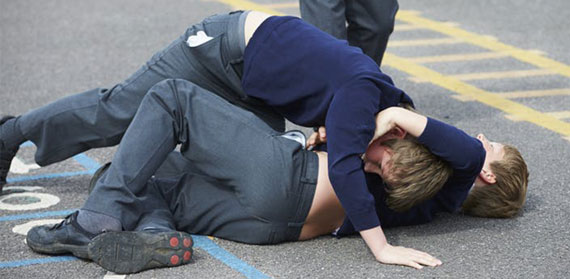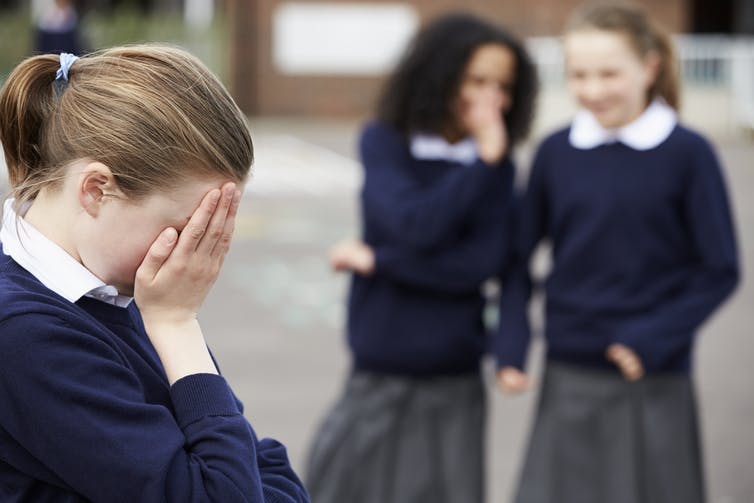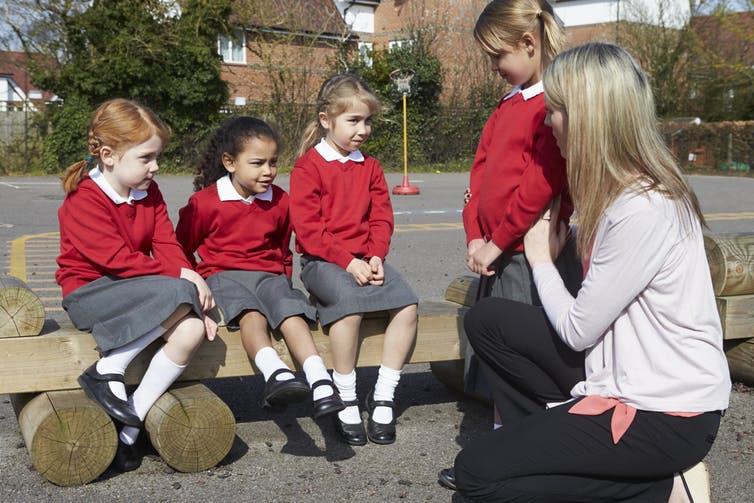Bullying is commonplace, and in some schools teachers are harassed and abused on a daily basis. Shutterstock
Guest post by Dr. Brian Moss
Violent behaviour in schools happens everyday and figures suggest bullying is on the increase, too. In a report last year, UNESCO (the United Nations office for educational, scientific and cultural affairs) revealed that school violence affects 246m pupils worldwide, every year.
Such violence is experienced through physical and emotional forms of harassment. And it can negatively impact pupils’ educational success and later employment and health prospects. Significantly, a link between school violence and later criminal justice involvement was noted in the report. Not addressed, however, was the earliest trigger for a child using violence.
Existing research points to different catalysts – such as parental violence, substance use and neglect – in the first 24 months of children’s lives as contributing to their own later violent conduct. The research shows that the peak age for violent behaviour is age six – which has implications for violence prevention and intervention policies.
These findings were recognised by the Stockholm Prize in Criminology for 2017, for their significance in terms of early child development and the possibilities for crime and violence reduction.
The UK picture
Education statistics show a general upward trend in violence in UK classrooms. Physical violence against pupils and staff, and verbal abuse of staff commonly feature.
Schools deal with such violence by excluding a pupil from school – for a fixed period or permanently. And the latest figures show 380,000 children were excluded from schools across the UK in 2016.
NSPCC figures suggest nearly half of children and young people have been bullied at school at some point in their lives. Shutterstock
In England, the Department for Education (DfE) has started a review into exclusions of pupils from schools. This is because recent statistics reveal certain children are being excluded from schools more so than others. This includes children from ethnic backgrounds, those with special needs and those from poorer schools that offer free meals.
Immediate concerns
The review will examine patterns in rates, race, and geographic areas. And it will report before the end of 2018. But while it’s good that exclusion rates are being investigated further, there’s no suggestion a connection will be made in the review, between early years development, school engagement or exclusion, and later life chances. This reflects a fragmented approach to school violence in England.
It was in 2011 that the education standards agency Ofsted last conducted a survey of “nurturing projects”. These were introduced to support school retention among difficult pupils and showed some successful outcomes at that time.
A December 2016 report on youth justice in England and Wales also pointed to children being “unnecessarily dragged” into the legal system. Though a Home Office action plan on alternative solutions to crime didn’t include schools in the report.
Then there is the issue that youth offending data only covers children age ten to 17. This is despite young children already being involved in criminal activities or behaviour. Children under ten, for instance, can be subject to a safety order – a court imposed penalty aimed at stopping children becoming involved in antisocial behaviour.
Another concern is that school exclusion orders can be imposed on children under five – almost 3,100 children under the age of five were excluded in England between 2015 and 2016. By leaving out these statistics, it creates a skewed picture of youth offending in England.
Crime or care in the classroom?
What all this shows, is that better data is required, as this could help to identify children in need in the early years and support efforts over teen years.
Better knowledge of problem solving or disciplinary processes in schools is also needed. Teachers often report disturbing stories of violence in schools, with support staff bearing the brunt of pupils’ aggressive behaviour.
There is also the issue of schools responding appropriately to disruptive behaviour. One approach to addressing violence in schools is through restorative practices. These aim to bring the offending and victimised pupil together. The idea is to try to get both sides to see the harm caused and prevent it from happening again. Though a report has found that restorative justice provision across England and Wales has been uneven – with not all local areas operating in this way.
More than a third of children feel their teachers don’t talk enough about what to do if they are bullied at school, a recent poll suggests. Shutterstock
An alternative approach to pupil aggression reported this year in one primary school was pupils carrying out “community service”. This is a sanction usually observed in criminal justice circles. But framing pupil misbehaviour as criminal also suggests a need to update discussions on policing in schools.
At present, UK Police perform liaison and restorative activities with schools. And though teachers and parents may be reluctant to include such matters, it needs to be considered whether this arrangement should also cover security and weapons control – including the use of knives and acid.
Ultimately, pupil violence needs a long-term solution informed by evidence. Continued, fragmented use of interventions and exclusion orders are unlikely to deliver safer schools and more responsible adults.
Originally written for ‘the Conversation’.






Comments are disabled